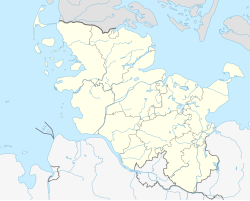
Back Helgoland ACE Helgoland Afrikaans Helgoland AN هليغولاند Arabic Heliqoland Azerbaijani Helgoland BAR Гельгаланд Byelorussian Хелголанд Bulgarian Helgoland Breton Helgoland Catalan
Heligoland
Helgoland | |
|---|---|
 | |
Location of Heligoland within Pinneberg district  | |
| Coordinates: 54°10′57″N 7°53′07″E / 54.18250°N 7.88528°E | |
| Country | Germany |
| State | Schleswig-Holstein |
| District | Pinneberg |
| Government | |
| • Mayor | Thorsten Pollmann (Ind.) |
| Area | |
• Total | 1.7 km2 (0.7 sq mi) |
| Elevation | 61 m (200 ft) |
| Population (2022-12-31)[1] | |
• Total | 1,253 |
| • Density | 740/km2 (1,900/sq mi) |
| Time zone | UTC+01:00 (CET) |
| • Summer (DST) | UTC+02:00 (CEST) |
| Postal codes | 27498 |
| Dialling codes | 04725 |
| Vehicle registration | PI, AG |
| Website | www |
Heligoland (/ˈhɛlɪɡoʊlænd/; German: Helgoland, pronounced [ˈhɛlɡoˌlant] ⓘ; Heligolandic Frisian: deät Lun, lit. 'the Land', Mooring Frisian: Hålilönj, Danish: Helgoland) is a small archipelago in the North Sea.[2] The islands were historically possessions of Denmark, then became possessions of the United Kingdom from 1807 to 1890. Since 1890, they have been part of the German state of Schleswig-Holstein, although they were managed by the United Kingdom as a war prize from 1945 to 1952.
The islands are located in the Heligoland Bight (part of the German Bight) in the southeastern corner of the North Sea and had a population of 1,127 at the end of 2016. They are the only German islands not in the vicinity of the mainland. They lie approximately 69 kilometres (37+1⁄2 nautical miles) by sea from Cuxhaven at the mouth of the River Elbe.
In addition to German, the local population, who are ethnic Frisians, speak the Heligolandic dialect of the North Frisian language called Halunder.
During a visit to the islands in 1841, August Heinrich Hoffmann von Fallersleben wrote the lyrics to the "Deutschlandlied", which became the national anthem of Germany.
© MMXXIII Rich X Search. We shall prevail. All rights reserved. Rich X Search



